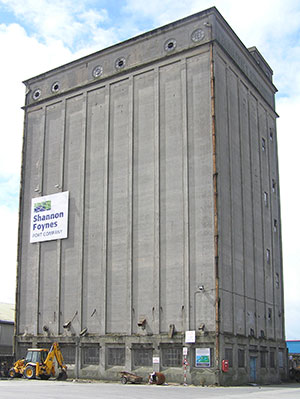Rank Silo at Shannon Mills
Published in Gems of Architecture, Issue 2 (March/April 2017), Volume 25Dock Road, Limerick
By Emma Gilleece

Above: The Rank Silo at Shannon Mills, Dock Road, Limerick. (NIAH)
Joseph Rank Ltd, today Rank Hovis McDougall (RHM), was founded by Joseph Rank (1854–1943) in Hull in 1875, and expanded to Scotland and Ireland in the late 1920s. After a visit to Limerick, Rank chose the city as headquarters for the newly established subsidiary, Rank (Ireland) Ltd, and took over the Goodbody Group in 1930. Thus Rank acquired the City, Mallow Street, Mount Kennett Provender and Newtown Pery mills and numerous grain silos. It was decided that a new modern mill on the docks was required to cut transport costs, and work on the construction of a suite of new grain silos began in early 1932. The new silos saw steam power give way to electricity from the new hydroelectric generating station at Ardnacrusha and the use of innovative materials and construction techniques. Progress on the first silo was swift, with the walls rising at a rate of four feet per day.
The silo now surviving was completed in 1935 for the government’s wheat-growing scheme and was ‘fitted with up-to-date grain-handling machinery and plant for the drying of Irish wheat’. The design has been attributed to Beckett and Harrington (formed 1918) of Cork and Dublin. An early example of a ‘ferro-cement’ or ‘ferro-concrete’ building, the structure comprises concrete poured and set over a layer of metal mesh and closely spaced thin steel rods. The steel used to reinforce the concrete was in short supply, however, and had to be sourced from across Europe.
As a largely unadorned tower, redolent of early twentieth-century modernism, the function of the silo’s interior space is clearly expressed on the exterior by a series of square openings at street level lighting the offices, vast expanses overhead devoid of openings but showing the rib-like concrete piers of the construction, and a series of paired oculus openings at the uppermost level. Going back to Classical antiquity, the vertical divisions of base (plinth), centre (shaft) and top (capital) recall the components of a fluted column.
Shannon Mills were an important source of employment in Limerick in the 1940s and 1950s and were valuable during the Emergency, when food supplies could not be imported. Profits began to fall in the 1960s, and Ireland’s entry into the EEC in the 1970s saw the market for home produce dwindle in the face of cheaper foreign imports. Rank (Ireland) Ltd closed in 1983.
One silo was removed in 1989, although its demolition was not without challenges; the reinforced concrete proved remarkably resilient to explosives but eventually succumbed to the wrecker’s ball. The surviving silo is a protected structure. DoCoMoMo Ireland organised an international architectural ideas competition, ‘Rank’s Silo in the 21st Century’, in 2014 as part of Limerick’s City of Culture activities. Three prize-winning entries envisaged the silo as a national seed vault, a basilica for public events and a cultural headquarters. Although finding a new use for the silo remains a challenge, it stands resolutely overlooking the docks as a monument to Limerick’s role as an important Irish industrial centre.
Emma Gilleece is an architectural historian. She chairs the Built Environment Committee of An Taisce and sits on the committee for the Limerick Chapter of the Irish Georgian Society. Series based on the NIAH’s ‘building of the month’, www.buildingsofireland.com.
















